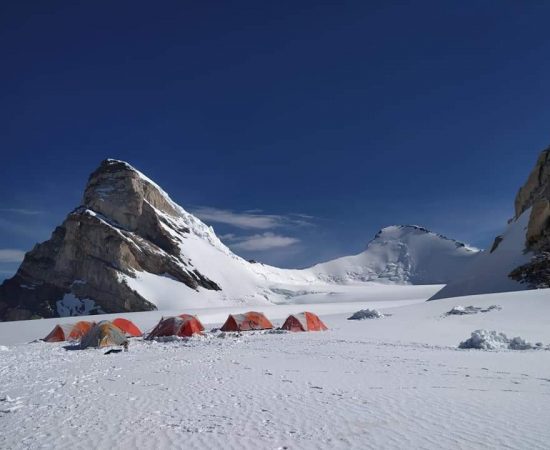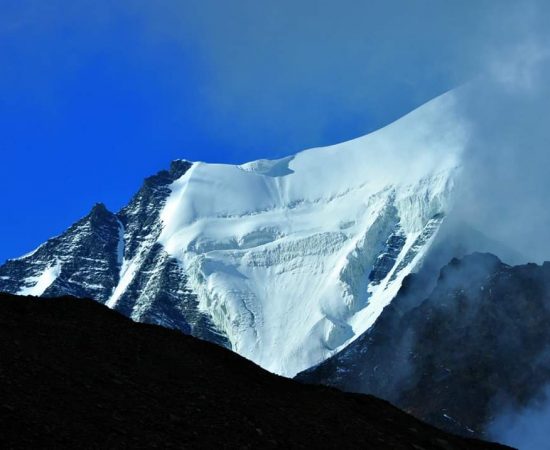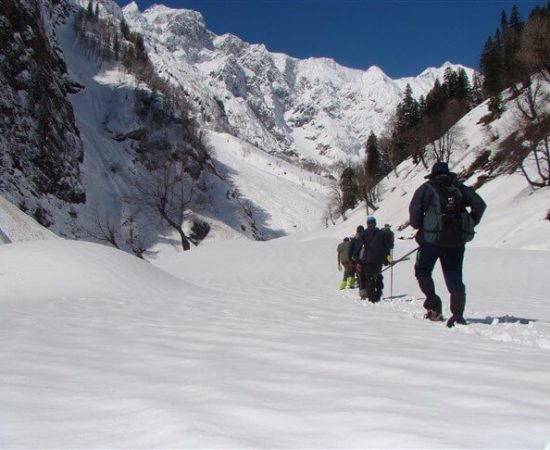Mt. Hanuman Tibba Expedition
Manali, Himachal
Rated 4.9/5.0 on TripAdvisor. 550 Reviews


Key Highlights
- Altitude : 6000 mts
- Time : 12 Days - 11 Nights
- Region: Manali
- Best Time: May, September
- Distance: 34 Kms
- Grade: Difficult
Overview
Mt. Hanuman Tibba Expedition
Near Manali in the Himalayas, at an altitude of 5932 metres, Mt. Hanuman Tibba is one of the most exciting mountains to climb. The hike to this pyramid-shaped summit takes you through the towering Tentu Pass after passing through the picturesque alpine meadows of Solang Valley, the glaciers and rivers of Beas Kund, and a few other valleys. The Hanuman Tibba excursion is not for the faint of heart, as it requires a complex climb and a high fitness level to complete successfully. Those with previous trekking experience, however, will find that this expedition is a worthy challenge. In order to climb well, you will need to be familiar with the specifics of using crampons and jumar. This adventure is once in a lifetime since from the peak you can see what seems like an infinite sea of mountains. If you're planning on going on the excursion, the months of June through October are ideal. Those interested in learning more about the Hanuman Tibba Expedition should continue reading.
Cost Per Person
Key Highlights
- Altitude : 6000 mts
- Time : 12 Days - 11 Nights
- Region: Manali
- Best Time: May, September
- Distance: 34 Kms
- Grade: Difficult
Complete
Itinerary of Expedition
The group should be in Manali by 11 a.m. today at the earliest. The day is important because it allows us to acclimatise a little bit, but it is also important because we need to gather together as a team and get necessary permissions for the expedition. Although Mt. Hanuman Tibba is on the International Mountaineering Federation's list of Trekking peaks, the organization's new procedure in the Manali area requires that teams submit an intimation and copies of identification documents for all members of the group, including the guide. The Indian Mountaineering Foundation (IMF) has established a regional office in Manali from which hikers may access the higher reaches of the Himalayas. We need one more permission from BRO and another from SDM, after we have received word on this indication from the IMF's regional office. Only drivers who want to travel between Solang Nala and Dhundi are needed to get these two permits. If we are unable to get any of these permissions, we will be forced to make the 7-kilometer trek down the riverside road from Solang Nala to Dhundi. Members of the team stay at the same hotel in Manali, where they may get to know one another better over some pleasant evening prep time. Evening time is left for leisure to enjoy the scenic beauty of the area. Overnight stay in a hotel.
Today, we will take a car and arrive at Dhundi by 8 a.m. Today, mules would transport our collective gear and food supplies to our new base camp in Bakkarthatch. With the trail’s consistent upward gradient, today's hike is rather simple. In Dhundi, we pass by three or four permanent camps from which "sailanis" may be seen at any time of the year. The path starts off on the day's left side of the Beas River. We'll be walking over a plank bridge without guardrails very soon. We're going to keep following the green path along the actual right bank of the Beas River from here. Snow may still be seen on the far left hills in May and June. Crossing two or three smaller creeks that feed into the main river is inevitable when you approach Bakkarthatch. The earliest we can expect to arrive is noon. We'll begin establishing our camp after lunch. Overnight stay in tents at Bakkarthatch.
After finishing our morning meal, we will continue with our ascent of the Beas Kund Glacier. A 300-meter-long moraine field is reached after a brief but strenuous ascent. You'll come across a wide plain sprinkled with stones and streams, with towering cliffs and hanging glaciers on each side. We will set our camp near the foot of Tentu Pass, a distance of several kilometres from Beas Kund. We will set up our base camp here and from this point onwards the real expedition begins as everything has to be carried by us. Overnight stay in tents at base camp.
We're taking today to relax and get used to the altitude. It is very important to hydrate and stay active at this altitude. After having our breakfast we will be going for an acclimatisation stroll on the upper side of the Beas Kund Glaciers. After returning, there will be a meeting to discuss our next steps and a technical equipment inspection and distribution, as well as a crampon fitting. Overnight stay in tents at base camp.
The rest of the crew will practice ice climbing on the glacier today as we take the load to our Advanced Base Camp just below Tentu Pass. This will be the start of the load ferry. We will pack the distributed equipment and ration which was done on the previous and start our steep ascent to the ABC. We're going back to camp base for the night.
We will take the same trail that we used to climb to the ABC for the load ferry the previous day but today we will establish the ABC. Overnight stay in tents at ABC.
We'll be hiking up an icy slope today, on our way to Camp 1. In between, right at the midway point, we will be making a short pit stop to have our lunch and re-energise for the route ahead. For the foreseeable future, snow will serve as our camping ground. We make the difficult ascent to the peak of Tentu Pass, which is infamous for its difficulty level as it has stopped many mountaineers from reaching the summit of Mt. Hanuman Tibba. The climb happens in almost a chimney like structure requiring technical know-how and endurance to make the Tentu pass. The key point of success is to never give up and always move forward. One may see the surrounding mountain ranges in all their splendour from the pass's peak. Overnight stay in tents at Camp 1.
Tackling crevasses and making your way over a continuous glacier is what today's adventure is all about. We will not encounter the steep and technical gradient that we faced the previous day. But, navigating through crevasse laden glacial fields is not an easy task either. We'll spend the night in Summit camp, where we'll be able to get ready for our summit bid the following day. This gives us a strategic advantage for our summit attempt by reducing the time and effort. Call it an early night and take as much rest as possible for the summit attempt.
We'll start for the summit push late after midnight, after warming up with a cup of tea and a quick breakfast to give us some energy. The route to the summit is long and arduous and requires tremendous physical and mental stamina to complete. From the top, you may take in sweeping vistas of the Dhauladar, Pir Panjal, and Greater Himalayan Ranges. After a successful summit bid, we'll make our way back to camp 1.
To descend from Camp 1 to Base camp we will take the same route that we used to climb up, while on the way we will be packing up our belongings today and taking it back with us. Overnight stay in tents at Base Camp.
We keep this extra day in case our summit attempt is delayed due to bad weather conditions.
The journey back to Dhundi and the waiting cars that will take you to Manali concludes today. This is our last farewell to you.
Enquiry For Group Bookings
Guidelines
➽ Preparation for Expedition
As you know every mountainous excursion demands a precise planning, a planning with adequate pliability of observing and tackling situations, held all as by overcoming mind body and soul throughout the incredible Himalayan journey.
So here are some aspects regarding Mt. Hanuman Tibba Expedition preparation:
⦿ Physically – A trek demands physical endurance, to prepare for each trek you should work out a month before joining a program. Build up the adequate strength in your legs by running and exercising every day to boost up your endurance. Stop smoking and boost your lungs doing breathing exercises at routine basis two times a day, which will help acclimatize the conditions while being resilient on the trek. Take active part in outdoor games, Yoga and any other cardiac exercises.
⦿ Mentally – Mental preparation is key, equally as important as physical training requisite for a trek. Before joining any trek take pleasure in your daily routines, eat well, take rest properly and relax. Do not stress your mind by unnecessary predictions about the trek. Be with your best friends to get motivated and relax your mind. Because pre trek assumptions are not worthy because once you join the trek and meet with rest of the pack will bring encouragement and excitement. The mental preparedness will build through the entire trek conditions. And the physical drawbacks will affect the mind. So pay close attention to various parts of the body and consciously let them loosen up as you trek. When you trek try to relax your body, especially your hips. If you’re on a winding downhill trail or on a panicking slant, think of each step as part of a simple dance and enjoy the natural rhythms that the terrain and your body can find together cautiously. Experiment with different ways of walking as a way of finding enjoyment beyond the goal of reaching a destination. The main key to stay mentally fit is to enjoy the route and not to pressurize the mind.
Guidelines
➽ Things to Carry
- Good Trekking Boots: You need sturdy trekking boots with supportive high ankles. Don't bring your running shoes. U can carry extra floaters/flip flops also.
- Wear warm clothing, such three-layer coats, fleece upper, hollow fill or down-filled jackets. Carry full-sleeved T-shirt. Carry cotton hiking trek pants and warm pant for your lower body. Never bring shorts or jeans on a hike.
- Take top and bottom thermals with you.
- Quick dry towel with light weight and Personal toiletries. Suns cream lotion, sanitizer, tooth brush ad toothpaste, lip balm and antibacterial powder.
- Socks: Bring two pairs of regular socks and two pair of wool socks for wearing at night.
- A head torch is required.
- Sunglasses/ Goggle: UV-protected sunglasses are necessary to protect against sunlight and Snow Mountain.
- There should also be a woolen cap / balaclava, cap, neck gaiter cum face mask and warm fleece and waterproof summit gloves since it will be chilly. Keep waterproof gloves on hand since they become wet in the snow.
- Everyone taking part in the activity should have their own lunchbox, spoon, mug and water bottle/ hydration pack of 2 ltr.
- Raincoats/ponchos: Since snowfall and rain are frequent at high elevations, it is important to have one on hand so as to avoid getting wet.
- Trekking bag of 75 ltr with rain cover.
- Walking stick.
- Personal first aid box. Emergency ration, energy bars, dry fruit, electoral/Ors
- Personal technical gears list of mountaineering (on rent basis available)
- Climbing boot, Crampon, Sleeping bag (optional), Ice axe, seat harness, Rope and tape sling, helmet, Summit gloves, Gaiters, Carabineers 2 no (screw), figure of eight/descendor, Zumar (Ascendor),
- Required Documents:
a) Registration Form
b) Medical Certificate (signed by a licensed MBBS physician)
c) NOC form (completed by the trekker)
d) 2 passport-size photos
e) ID Proof photo (not PAN)
f) Basic Mountaineering Course certificate.
g) Insurance upto 5 lac..
Guidelines
➽ How to Reach
How to reach Manali:
Delhi and Manali are linked nicely. You may travel from Delhi to Manali in 12 to 14 hours via overnight bus (approx 540 KMS). Online ticket reservations are available at www.redbus.in and www.hrtc.gov.in Tip: Given the distance between Delhi and Manali, the majority of Volvo private buses depart Delhi between 5 and 8 p.m. At 8.30 p.m., the final government bus departs from ISBT Kashmere Gate. Between Rs. 1,200 and Rs. 1,800 are charged by Volvo buses each sector from Delhi to Manali and vice versa. Delhi to Manali: Buses depart from Manali for Delhi between 4 and 8 p.m., same like the return trip. You should expect to arrive in Delhi any time between six and ten in the morning. Plan your subsequent trips just after midday, leaving ample time for bus delays.
How to reach Naggar:
Naggar is 18 kilometres from Manali, and there are several buses that operate every 15 minutes. Alternatively, one may get out at Patlikuhal, which is 5 kilometres from Naggar on the right bank highway. Between Kullu and Manali is Patlikuhal. To get to Naggar, you may take a cab or a local bus from Manali or Patlikuhal.
The closest train station is:
Ambala (350 miles) and Chandigarh are the closest railway stations (310 kms). Advice: From Chandigarh to Manali, regular buses and Volvos run in the evening. Volvo buses from Chandigarh to Manali and vice versa charge between Rs. 800 and Rs. 1,200 every sector.
The closest airport:
The closest airport to Manali is Bhuntar, which is 52 kilometres distant. From Bhuntar to Manali, taxi services are available and cost between Rs. 1500 and Rs. 2,500. Air travel between Bhuntar and Delhi is convenient. Airlines providing flights from Delhi and Chandigarh to Kullu include Indian Airlines, Kingfisher Airlines, MDLR Airlines, and Jagson Airlines.
➽ Trip Cost Includes
- Mountaineering (Instructor/guide) services provided by a highly trained, professional, and qualified Himalayan Adventure Trips staff.
- Certified local guide with extensive familiarity of the area.
- Climbing provides only vegetarian food (breakfast, lunch, and dinner).
- Staff include chefs, cooks, and helpers.
- High Altitude Force, Low Altitude Force, Porters, Mules for Common Equipment (Rations, Tents, Utensils, Central Climbing Equipment, etc.)
- Tents (to be shared), sleeping bags, air mattresses, and air pads are included. Inner
- We offer twin-share accommodations in dome, alpine, and high-altitude tents on all of our treks and expeditions. All necessary camping equipment, including air mattresses, a shelter for cooking and eating, a table and chairs, a stool, and more, would be supplied.
- Someone who can carry heavy items, set up high camps, repair ropes, etc. at high altitudes.
- Assistance from Guide All the Way to the Top
- High-altitude butane gas cooker
- The only meal offered at the hotel will be breakfast. All meals while on the walk will be supplied for you. Indian, Chinese, and Continental cuisines, all freshly cooked, will be on the menu.
- Tin-packaged food is what we'll eat at high altitude.
- A standard first aid kit with oxygen masks for the patient.
- Camping fees, wildlife fees, and forest permits.
- Taxes imposed by the state.
➽ Trip cost Excludes
- Climbers may hire individual porters to carry their gear.
- Airport transportation costs
- Expenses for carrying still/video cameras etc.
- Irregular/Personal costs, such as laundry, phone calls, and gratuities.
- Climbing equipment such as ropes, pitons, snow bars, crabs, etc.
- Your own personal mountaineering equipment and clothes, as well as any specialised foods you may need
- Inner Line Permit.
- Health coverage or the price of a rescue mission
- Expenditures of a more personal character (such as booze, soda, bottled water, mineral water, canned or bottled drinks, candy, canned or packaged dried fruits, etc.)
- Provisions/food to or from the starting point of the trek.
- Any expenses that are incurred as a result of natural disasters, human error, or other unforeseeable occurrences.
- Protect your trip with a travel insurance policy.
- Authorization, licensing, and enlistment with the IMF.
- Payment for Liaison Officer (included for foreign expedition only)
- GST of 5%.
Guidelines
➽ Special Casual Leaves
Government employee can avail the benefit of special casual leave when u join us for a trekking expedition. As per the rule of the pay commission, special casual leave can be availed for up to 30 days in a calendar years for trekking and mountaineering expeditions through a register organization. Himalayan adventure trips are a register adventure tour operator register with Indian mountaineering foundation and Himachal Pradesh tourism. Candidates have to apply for leave at least 30 days before the trek/expedition start.
Testimonials
➽ Provided By The Customers
Climbing Hanuman Tibba in August 2019 with Good Company
In the company of Hat, Sameer, Arun, and I climbed to the summit of Hanuman Tibba (at an altitude of 5932 metres). With Shera at the helm as the chief guide, along come Vishal, Panna, and Jaggi, who work together to form a tight-knit, effective, and amiable unit. The majority of our time was spent in a high-quality 4-person tent; the given gear was not brand new but adequate, with the exception of a few small difficulties with one of the sleeping bags. Both the meal and the hot beverages were delicious. Manu was simple to get in touch with before to our adventure, and he answered all of our questions (there weren't many) thoroughly. Basically, my time spent on adventure with Himalayan Adventure Trips was both personally rewarding and professionally enriching.
How useful was this post?
Click on a star to rate it!
Average rating 0 / 5. Vote count: 0
No votes so far! Be the first to rate this post.





